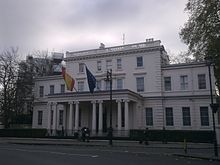Embassy of Spain, London
| Embassy of Spain in London | |
|---|---|
 | |
 | |
| Location | Belgravia, London, UK |
| Address | 24 Belgrave Square London, SW1 |
| Coordinates | 51°29′51.7″N 0°9′14.7″W / 51.497694°N 0.154083°W |
| Ambassador | José Pascual Marco Martínez |
The Embassy of Spain in London is the diplomatic mission of Spain in the United Kingdom.[1] Formerly known as Downshire House, the embassy is located at 24 Belgrave Square in the Belgravia area of London. Spain also maintains a Consulate General at 20 Draycott Place in Chelsea, a Defence Office at 3 Hans Crescent in Knightsbridge, an Education, Employment & Social Affairs Office at 20 Peel Street in Holland Park, and an Economic & Commercial Section at 66 Chiltern Street in Marylebone.[2]
The embassy is situated in a detached, stucco house designed by Henry E. Kendall and built between 1840 and 1850 on Belgrave Square in Belgravia. The building is Grade I listed for its architectural merit.[3]
History
[edit]In the reign of Elizabeth I, the Bishops of Ely let their palace and chapel in Ely Place to the Spanish Ambassador and, until the reign of Charles I, it was occupied by the High Representative of the Court of Spain. During this period, the chapel (now St Etheldreda's Church) was freely used by English Roman Catholics.[4]
After the restoration of Charles II, the Spanish Embassy was re-established in London, first on Ormond Street and then at Hertford House on Manchester Square, where the Wallace Collection is now housed. Here, in 1793–96,[5] shortly after the Roman Catholic Relief Act 1791 repealed some of the laws affecting Catholic worship, a chapel, St James's, Spanish Place, was built to designs by Joseph Bonomi on the corner of Spanish Place and Charles Street (now George Street), Westminster, largely through the efforts of Thomas Hussey, chaplain at the embassy. In 1827, the official Spanish connection with the chapel ceased.
Between the late-20th century and onwards, the house was owned by Lord Pirrie, the director of Harland & Wolff, a prominent Belfast shipbuilding company, which generally built ocean liners for the White Star Line.[6] During one occasion in July of 1907, Pirrie was hosting White Star managing director J. Bruce Ismay at the residence, discussing the two-months subsequent voyage of the Lusitania in September. Having been longstanding rivals with Cunard throughout most of their history, Ismay expressed concern at the record-breaking transatlantic crossing of the Lusitania with Pirrie; Despite White Star's reputation for elegance and luxury, Cunard's notability for punctuality and speed posed a threat to both of their respective firms to a great extent.[7] Pirrie formulated the concept of a large three-stack liner constructed in order to compensate for the recent ascension of Lusitania, with an emphasis upon prestige as well as her design. Moreover, this would advance to a new class of three liners being constructed as opposed to Cunard's Mauretania and Luistania duo, with an additional liner laid upon to forward themselves ahead of Cunard.
These were the preliminary foundations for what would become known as the Olympic-class ocean liner, a trio of famous liners built between 1908 until 1914, thus being the Olympic, Titanic along with Britannic. After initial groundwork drawn up by Alexander Carlisle, a veteran architect of Harland & Wolff, and Thomas Andrews, another who was Pirrie's nephew, an additional smoke stack was extended to the blueprints, a feature designated to enhance the vessels' appearance, therefore rendering the original proposition a four-stacker liner.[8] The contract was agreed upon on in a drafted agreement between White Star and Harland & Wolff a year afterwards in July of 1908, facilitated as well as signatured by both Pirrie and Ismay in approval. The most famous of the three liners, Titanic, later sank on her maiden voyage to New York in April of 1912 after a collision with an iceberg, resulting in the deaths of over 1,500 aboard, with circa 706 rescued by the Carpathia. Pirrie and his subordinate engineers were not implicated in the subsequent British and American Inquiries over the shortage of lifeboats on board, however Ismay himself infamously received the brunt of the blame for the disaster, ruining his reputation amongst society. Pirrie later passed away over a decade later in 1924, ironically near the coast of the former Spanish colony of Cuba.
The house became a Spanish diplomatic representation less than five years after his death in 1928 after being purchased by the Spanish government.[9]
Gallery
[edit]-
Plaque outside the embassy depicting the coat of arms of Spain
-
Entrance on Chesham Place
See also
[edit]- Category:Ambassadors of Spain to the Kingdom of England
- Category:Ambassadors of Spain to the United Kingdom
References
[edit]- ^ "The London Diplomatic List" (PDF). 14 December 2013. Archived from the original (PDF) on 11 December 2013.
- ^ "The London Diplomatic List" (PDF). 14 December 2013. Archived from the original (PDF) on 11 December 2013.
- ^ Historic England, "Spanish Embassy (1218320)", National Heritage List for England, retrieved 2 March 2016
- ^ "Parish History". SJSP. 24 October 2013. Archived from the original on 29 October 2013. Retrieved 28 February 2017.
- ^ Dates according to Howard Colvin, A Biographical Dictionary of British Architects 1600-1840, 3rd ed., s.v. Joseph Bonomi.
- ^ "Downshire House - London". www.wikimapia.org. Retrieved 1 July 2024.
- ^ "Downshire House". www.encyclopaedia-titanica.org. Retrieved 1 July 2024.
- ^ "Downshire House; London". www.titanic.memorial. Retrieved 1 July 2024.
- ^ "A brief history". exteriores.gob.es. Retrieved 1 July 2024.



